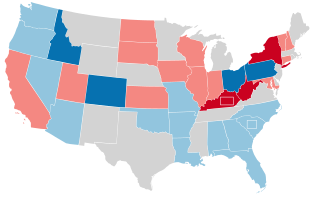
The 1956 United States Senate elections were elections for the United States Senate that coincided with the re-election of President Dwight D. Eisenhower. The 32 seats of Class 3 were contested in regular elections, and three special elections were held to fill vacancies. Although Democrats gained two seats in regular elections, the Republicans gained two seats in special elections, leaving the party balance of the chamber unchanged.

A general election was held in the U.S. state of North Dakota on Tuesday, November 2, 2010, with primary elections being held on June 8, 2010.

The 1926 United States Senate special election in North Dakota took place on June 30, 1926. On June 22, 1925, Republican Senator Edwin F. Ladd died in office. Governor Arthur G. Sorlie appointed Gerald Nye, a former congressional candidate and a prominent progressive activist, to fill Ladd's vacancy. A special election and regularly scheduled election were scheduled for the same year, though the special election, to fill the remaining months Ladd's term, took place months before the regularly scheduled election.

The 2020 United States presidential election in North Dakota was held on Tuesday, November 3, 2020, as part of the 2020 United States presidential election in which all 50 states plus the District of Columbia participated. North Dakota voters chose electors to represent them in the Electoral College via a popular vote, pitting the Republican nominee, incumbent President Donald J. Trump from Florida, and running mate Vice President Michael R. Pence from Indiana against Democratic nominee, former Vice President Joe Biden from Delaware, and his running mate Senator Kamala Harris of California. North Dakota has three electoral votes in the Electoral College.

The 1968 North Dakota gubernatorial election was held on November 5, 1968. Incumbent Democrat William L. Guy defeated Republican nominee Robert P. McCarney with 54.82% of the vote.

The 1960 North Dakota gubernatorial election was held on November 8, 1960. Democratic nominee William L. Guy defeated Republican nominee and Lieutenant Governor Clarence P. Dahl with 49.44% of the vote.

The 1948 North Dakota gubernatorial election was held on November 2, 1948. Incumbent Republican Fred G. Aandahl defeated Democratic nominee Howard I. Henry with 61.33% of the vote.

The 1966 Iowa gubernatorial election was held on November 8, 1966. Incumbent Democrat Harold Hughes defeated Republican nominee William G. Murray with 55.34% of the vote.

The 1944 North Dakota gubernatorial election was held on November 7, 1944. Republican nominee Fred G. Aandahl defeated Democratic nominee William T. DePuy with 52.02% of the vote.

The 1936 North Dakota gubernatorial election was held on November 3, 1936. Nonpartisan League nominee William Langer defeated incumbent Republican Walter Welford with 35.80% of the vote.

The 1942 Iowa gubernatorial election was held on November 3, 1942. Republican nominee Bourke B. Hickenlooper defeated Democratic nominee Nelson G. Kraschel with 62.75% of the vote.

The 1930 North Dakota gubernatorial election was held on November 4, 1930. Incumbent Republican George F. Shafer defeated Democratic nominee Pierce Blewett with 73.62% of the vote.

The 1928 North Dakota gubernatorial election was held on November 6, 1928. Republican nominee George F. Shafer defeated Democratic incumbent Walter Maddock with 56.50% of the vote.

The 1924 North Dakota gubernatorial election was held on November 4, 1924.

The 1932 Washington gubernatorial election was held on November 8, 1932. Democratic nominee Clarence D. Martin defeated Republican nominee John Arthur Gellatly with 57.29% of the vote.

The 1916 North Dakota gubernatorial election was held on November 7, 1916. Republican nominee Lynn Frazier defeated Democratic nominee D. H. McArthur with 79.24% of the vote.

The 1914 North Dakota gubernatorial election was held on November 3, 1914. Incumbent Republican L. B. Hanna defeated Democratic nominee Frank O. Hellstrom with 49.58% of the vote.

The 1910 North Dakota gubernatorial election was held on November 8, 1910. Incumbent Democrat John Burke defeated Republican nominee C. A. Johnson with 49.96% of the vote.

The 1908 Washington gubernatorial election was held on November 3, 1908. Republican nominee Samuel G. Cosgrove defeated Democratic nominee John Pattison with 62.56% of the vote.

The 1908 North Dakota gubernatorial election was held on November 3, 1908. Incumbent Democrat John Burke defeated Republican nominee C. A. Johnson with 51.06% of the vote.























